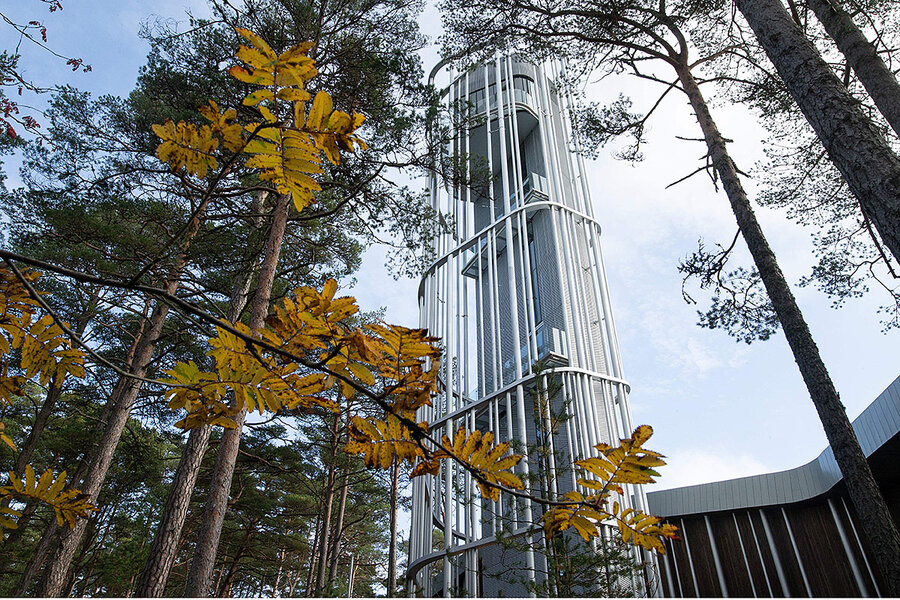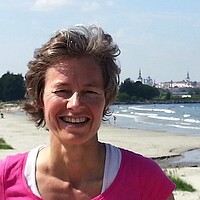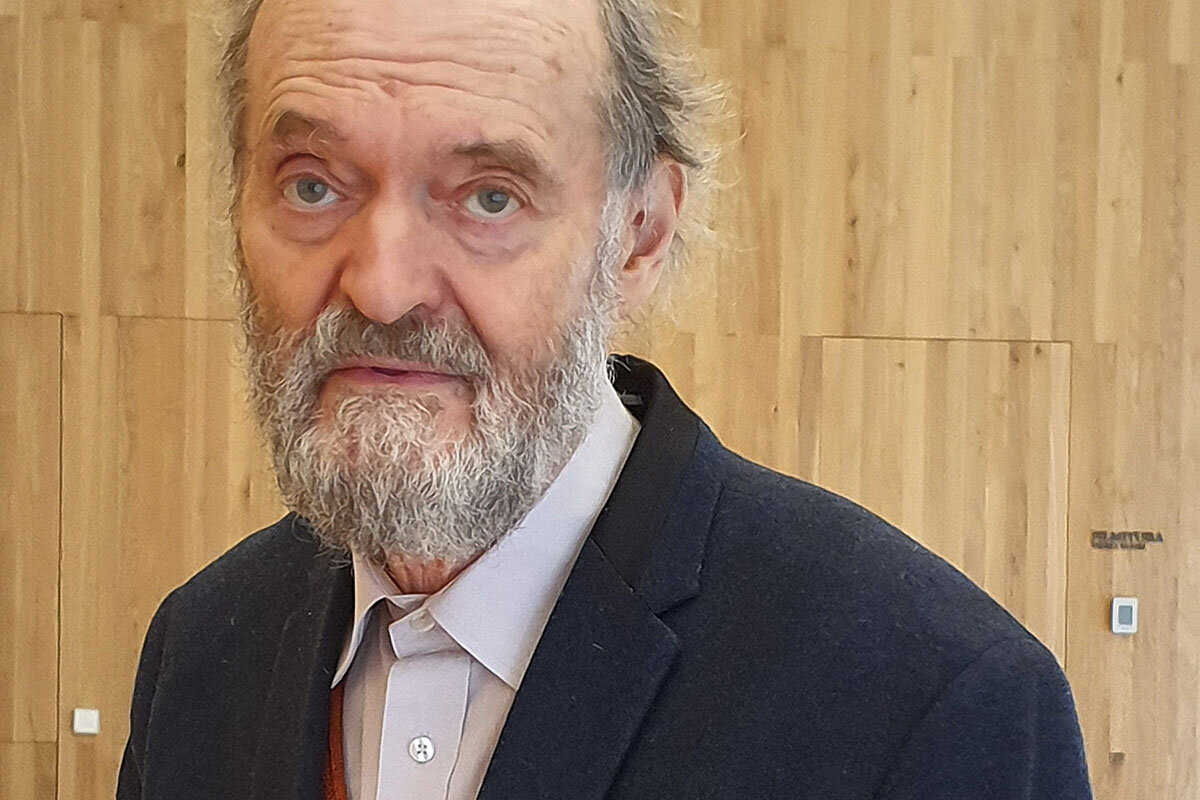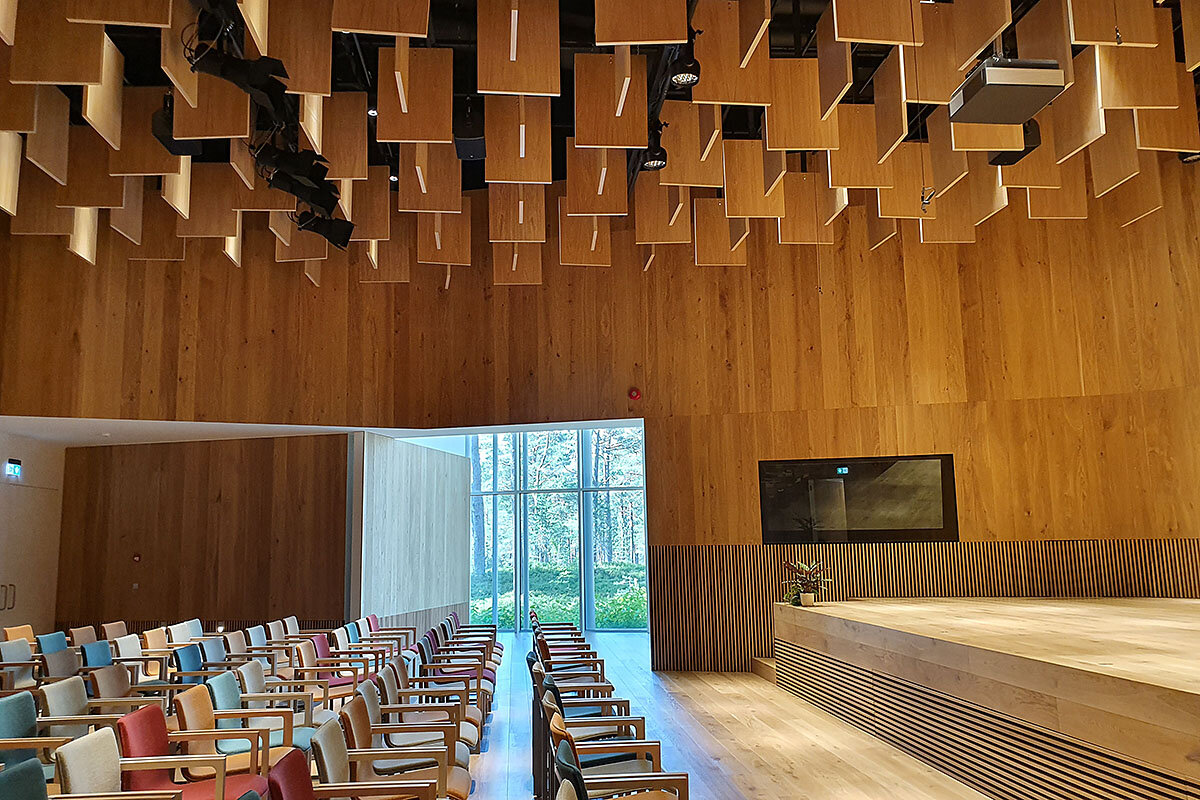‘Silence is here’: Estonia pays homage to composer Arvo Pärt
Loading...
| Laulasmaa, Estonia
Walking beneath the whispering pines of Estonia’s majestic forests, along a path edged by pale-colored lichen and blueberry plants, a visitor arrives at a curved building that seems to rise out of the earth. It’s a music center and a library devoted to world-renowned Estonian composer Arvo Pärt, whose compositions translate the stillness and peace of his country’s forests into sound.
The Arvo Pärt Center is nestled in the forest where the composer and his wife live, an hour outside the capital, Tallinn. The 30,600-square-foot, pentagon-shaped structure is a joint venture between the Pärt family and the Estonian government, which financed it. That this project became reality in a country of only 1.3 million people testifies to how culture – and Mr. Pärt’s role in it – is embraced by Estonians.
Exiled for decades because of antagonism from the former Soviet government, Mr. Pärt returned to Estonia in 2010. Calling him a cultural ambassador, President Kersti Kaljulaid said that the composer’s work – particularly his 1978 “Spiegel im Spiegel” (Mirror in the Mirror) whose radical simplicity revolutionized music – continues to “say more in today’s confusingly multipolar world than perhaps ever before.”
Why We Wrote This
Stillness brings sweet relief to a fast-paced world. An international composer’s music offers just that. Fittingly, his country celebrates his lifework in a new center nestled in a forest.
“Through your music we can experience the multitude of sounds hidden within one carefully considered note,” President Kaljulaid told international guests assembled at the opening celebration in October.
It is a fitting tribute, says Tõnu Kaljuste, the founder of the Estonian Philharmonic Chamber Choir and Tallinn Chamber Orchestra, who is regarded as one of the composer’s most trusted interpreters. “Pärt is not your typical classical composer. He thinks differently, and this center is a place where people can think differently,” he says.
Few other living composers have reached such a worldwide audience as Mr. Pärt, an adherent of the Christian Orthodox faith.
Simplicity, silence, and spirituality are woven together in the tapestry of his music, allowing him to “penetrate the soul of so many different kinds of listeners,” says Peter Bouteneff, who teaches at St. Vladimir’s Orthodox Theological Seminary in Yonkers, New York. The composer has influenced generations of musicians, from Keith Jarrett and Radiohead to Sting and John Adams, and his music has been featured in films such as “Fahrenheit 9/11.” He’s perhaps best known for his choral compositions, many of them set to religious texts.
“Arvo Pärt has created a whole new musical aesthetic of stillness and hypnotic beauty that is very refreshing in today’s fast-paced world,” says composer Eric Tuan from Palo Alto, California. “His music speaks to people who are searching for quiet, reflection, stillness, spirituality, even if the people are not particularly religious.”
And now precious bits of Mr. Pärt’s creative history are sheltered at the new center. They help visitors understand a unique journey shaped by the Soviet authorities’ ban of the 1968 piece “Credo” (“I believe” in Latin), his subsequent eight years of creative silence and spiritual search, and the new composition style that resulted.
Original scores are included, as well as diaries Mr. Pärt kept in the 1970s when he was searching for a new voice. The diaries include various harmonic accompaniments to melodies marked in bright-colored ink, along with comments he wrote in Estonian, Russian, Latin, German, and English.
The center’s mission is to bring researchers and lay people closer to his music, and to the creative process.
“We want to teach how to listen to music,” says film-music editor Michael Pärt, Mr. Pärt’s youngest son and the driving force behind the center. “My father’s music works very well because it needs a certain amount of endurance to listen to.”
Mr. Pärt no longer gives formal interviews. But, on his way to the little office at the center, he sometimes stumbles upon and questions visitors with humility and curiosity that those who know him say define his personality. Asked about the role of silence in his music during a recent encounter with a journalist, the composer placed his hand on his heart. “Silence is here,” he said.
Mr. Pärt explained to a German journalist in 1988, “I cannot say in a thousand sentences what I can say in a few notes.” Studying Gregorian chant, he said, “taught me what a cosmic secret is hidden in the art of combining two, three notes.”
The center’s design was “inspired by the silence, beauty, and the geometry of Arvo Pärt’s music,” says Enrique Sobejano of Nieto Sobejano Arquitectos, who was selected out of a field of 70 architects from 21 countries to design the $9 million center.
The center is sparsely furnished and there are no corners or right angles so that the space flows. There’s a library with books that have influenced Mr. Pärt, including many theology books, a 140-seat concert hall, and a video room. Courtyards and glass panels let the forest and the light into the building.
There’s a little chapel and a tower with a spiral staircase that opens onto views of the Baltic Sea.
“The tower is to the sea, to the heavens. It’s just the subjective part of my father’s music,” Michael Pärt says. “You need to have inspiration in order to do everything that’s inside this place.”








